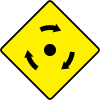Tag:highway=mini_roundabout
| Description |
|---|
| A road junction where the traffic goes around a painted circle or traversable island and has right of way. |
| Rendering in OSM Carto |
| Group: highways |
| Used on these elements |
| Useful combination |
| See also |
| Status: de facto |
| Tools for this tag |
|
A ![]() mini-roundabout is a special type of roundabout in which the middle can be traversed by vehicles, and is typically used where there is only limited space available. Road traffic flows in one direction around a point in the middle and the traffic in the roundabout has right-of-way. The middle of a mini-roundabout is usually only a painted circle, but there might also be a low, fully traversable (mountable) dome or island.
mini-roundabout is a special type of roundabout in which the middle can be traversed by vehicles, and is typically used where there is only limited space available. Road traffic flows in one direction around a point in the middle and the traffic in the roundabout has right-of-way. The middle of a mini-roundabout is usually only a painted circle, but there might also be a low, fully traversable (mountable) dome or island.
Please pay attention to the section Possible misinterpretations to differentiate between roundabouts, traffic circles (rotaries), mini-roundabouts, turning circles and turning loops.
How to map
Add the tag highway=mini_roundabout directly on the junction node where two or more ways intersect. The key direction=clockwise/anticlockwise can be added to reduce the need of assumptions about local traffic flows. In case the traffic flow is clockwise, the tag direction=clockwise should be added as the default rendering of major renderers is anti-clockwise.
Traversability
Central circle can be traversed but it may be illegal. If there is only a single vehicle, or two vehicles travelling in opposite directions, it is common in at least some countries – to drive straight across the middle rather than going around. This action may be illegal in some countries. In particular, large vehicles are typically allowed to drive across the centre island if otherwise not possible due to their dimensions.
Examples
Signs
Mini-roundabouts are usually indicated by signs, like e.g. one of these:
Mini-roundabouts
The following table shows a selection of classical mini-roundabouts: they all are one-ways with either a painted circle or a fully traversable island in the middle, and the traffic within the mini-roundabout has right-of-way. Please note, that the key direction=* only needs to be specified if the traffic flow on the mini-roundabout is clockwise as the default value for this key in conjunction with mini-roundabouts is anti-clockwise.
Possible misinterpretations
In OpenStreetMap we have several tags that describe different circular and widened road features.
- junction=roundabout for roundabouts;
- highway=mini_roundabout for mini-roundabouts;
- junction=circular for rotaries (traffic circles) and other circular traffic that is not a roundabout;
- highway=turning_circle for turning circles;
- highway=turning_loop for turning loops;
- highway=passing_place for road passing places; and
- traffic_calming=island for islands meant to calm traffic.
The major differences between the first four are:
- A roundabout is a one-way street with right-of-way and a non-traversable centre island. There can be traffic light, as long as the circular road has right-of-way when the lights are off.
- A mini-roundabout is a one-way street with right-of-way and a traversable centre island. In particular, large vehicles are allowed to drive across the centre island if otherwise not possible due to their dimensions, i.e. it might be impossible for a large vehicle to drive through a roundabout but possible to drive through a mini-roundabout with the same dimensions.
- A circular junction is a one-way street around a non-traversable centre island, however the circular traffic has not always the right-of-way, it has to yield at some or all incoming roads. This includes traffic circles with such yield regulations as perceived in the United States.
- A turning circle is a widened space on a two-way street without any centre island (or at least a fully traversable island). The absence of a centre island allows also large vehicles to turn around.
Why is it important to follow this tagging guideline if the map looks good even when tagged differently?
The map is not everything. There exist a lot more applications which process our data and these tags have different implications e.g. for routers. So if you tag a small roundabout as a mini-roundabout or a loop at the end of a street as a turning circle, it might look ok on the map but will break other applications. So please don't think of this as annoyance and try to use the most fitting tags in each situation.
The following table presents the preferred tagging for the most common situations and also tries to clarify some ambiguities.
| Photo | Tagging | Remarks |
|---|---|---|

|
highway=* junction=roundabout |
A standard roundabout with a large, non-traversable centre island. |

|
highway=* junction=roundabout
|
Small, but not a mini-roundabout. Although it is preferred to tag this the same way as a large roundabout, for the sake of simplicity it is acceptable to tag this with a single node with junction=roundabout. In this case the tag direction=* should be specified, as its default value is anti-clockwise when used in conjunction with a roundabout. |
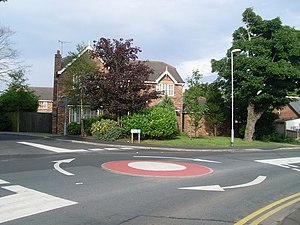
|
highway=mini_roundabout direction=clockwise |
A classical mini-roundabout where the centre is only a painted circle. The tag direction=* should be specified, as its default value is anti-clockwise when used in conjunction with a mini-roundabout. |
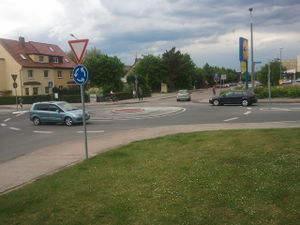
|
highway=mini_roundabout |
Large, but a mini-roundabout. The centre island is traversable and without signposts. |
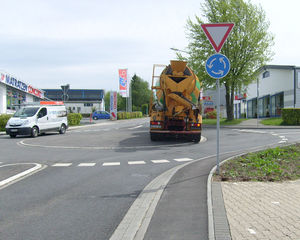
|
highway=mini_roundabout |
Also a classical mini-roundabout with a slightly raised but still fully traversable centre island. |
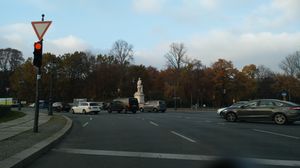
|
junction=circular |
Traffic routed in a circle, with a large, non-traversable centre island. However the circular traffic must yield for at least one, some or each entering road, thus not a roundabout. |
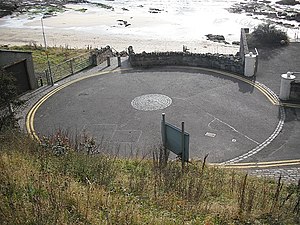
|
highway=turning_circle |
This photo shows a round place with a traversable island in the middle, but this is neither a mini-roundabout nor a roundabout, but instead a turning circle, which allows large vehicles to turn around. Please bear in mind that a turning circle can have any shape, but never a non-traversable island. |
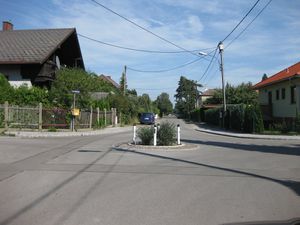
|
There are no indications of right-of-way, so this is a circular junction rather than a roundabout. There are no one-way indications, so the circular way should be tagged oneway=no. | |
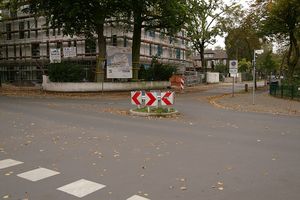
|
This is also a circular junction with traffic calming. Watch the arrows closely to figure out whether to tag the circular way with oneway=yes or oneway=no. | |

|
or alternatively proposed
|
Obviously a place for vehicles to turn around. But because of the island, it is not a turning circle (which must not have an island), so this should be mapped as a loop. For the sake of simplicity the tag highway=turning_loop on a single node is currently under discussion. |
In addition, note that many regular junctions have painted circles or circles of contrasting pavement as a traffic calming measure. Without the combination of mandatory circular movement on the junction and priority for traffic on the junction, such markings do not indicate a mini_roundabout.
Note to data consumers
Due to a lack of clarity in the documentation for several years, smaller roundabouts or turning loops have often been tagged with highway=mini_roundabout, rather than using junction=roundabout or highway=turning_loop. Data consumers therefore should be cautious to assume the centre of a junction tagged with highway=mini_roundabout can be traversed by large vehicles, especially if the tag was added before June 2012.
Related tags
See also
- Informations about mini-roundabouts on Wikipedia
- UK Highways Agency Design Manual for Roads and Bridges - Volume 6, Section 2, Part 3: Geometric Design of Roundabouts: Mini-roundabouts are explained on page 3/2
- US Federal Highway Administration Safety Program - Technical Summary - Mini-Roundabouts
- Wikipedia article about traffic circles


